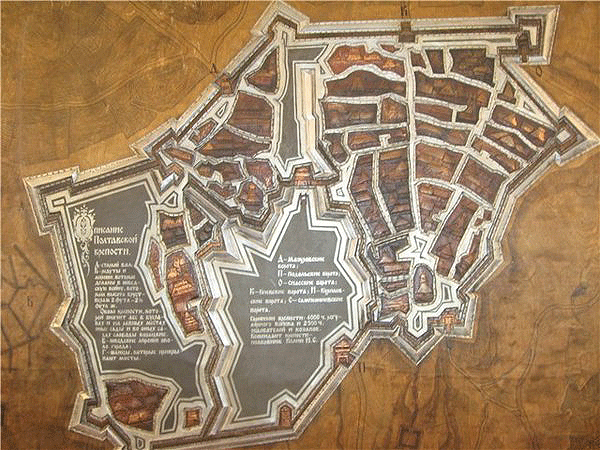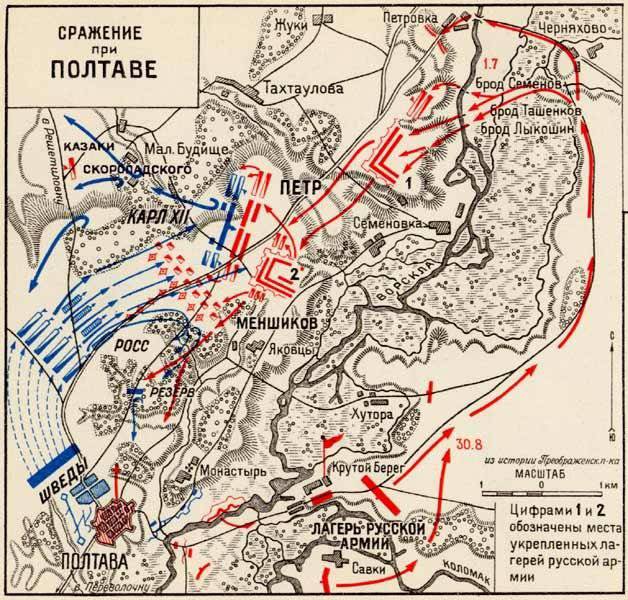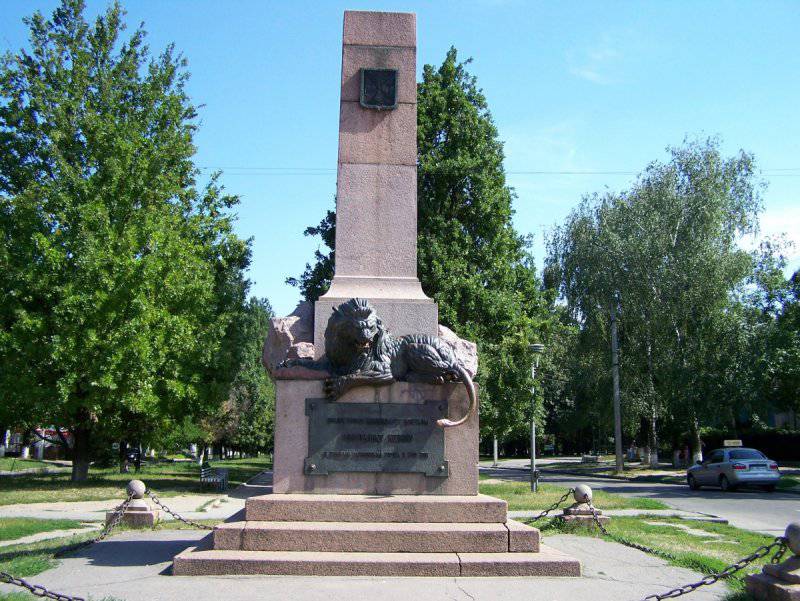Heroic defense of Poltava
In the spring of 1709 of the year 35 thousand. The Swedish army resumed its movement - Karl wanted to repeat the attack on Moscow, but through Kharkov and Belgorod. To create a base for the development of the offensive, the Swedish command decided to seize the fortress of Poltava.
Heroic defense of Poltava
By the end of April, the Swedish king began to tighten his forces towards Poltava. There was a garrison of 4 Thousands of soldiers (2 battalion of Ustyug, 2 battalion of the Tseks, 1 battalion of the Perm regiments, 1 battalion of the Colonel von Fichtenheim regiment, 1 battalion of the Apraksin regiment) and 2,5 thousand of the forces of the search for each of the 17 Alexey Stepanovich Kelin.
Poltava lies on the right, high and steep, the banks of the Vorskla River. Near Vorskla flows p. Kolomak forms a wide and low valley covered with impassable swamps. As a result, the communication of Poltava with the left bank of the Vorskla was very difficult. The fortress railing of Poltava was located in the form of an irregular polygon, in addition, there was an earthen ramp strengthened by a palisade, and there was a moat in front of the rampart. The suburb was located in front of the northern wall of the fortress, its eastern and western parts were edged with ravines. In the east they approached closely, in the west - meters on 200, there were small ravines inside Poltava, dividing it into two unequal parts. The southeast side, due to the height of the shaft, was more accessible for the assault. But the enemy, having mastered the shaft, went to the bottom of a ravine with steep slopes. The approaches to Poltava from the east also did not provide any facilities for an assault or an engineering attack - the ravine closely approached the shaft of the fortress. On the north side, the besiegers greatly hindered the suburb: the siege work had to start from a relatively far distance from the fortress wall. The most advantageous was to storm from the west: a ravine covered the besiegers, but here the garrison had the opportunity to use the ravine inside the fortress and create a new strong internal defensive line. Poltava was of great importance - it was a junction of paths, a shopping center and a fortified point, which could be used as a base for further war.
Even before the beginning of the siege, at the direction of Peter, the Poltava fortress was put in order, food and ammunition stocks were created. Artillery park of the fortress consisted of 28 guns.

By the end of April, the main forces of the Swedish army were concentrated at Poltava. They settled partly in a fortified camp, and partly in the surrounding settlements. To cover the main forces from a possible attack from the Russian army in Budishchakh there was a squad of Ross from 2 infantry and 2 dragoon regiments. Siege works were entrusted to quartermaster general Gillenkrok. He believed that Poltava should not be besieged, since the army has few guns and there is a shortage of ammunition. But Karl insisted on the siege of Poltava.
The Swedes of 28 and 29 of April staged two assaults, trying to take Poltava on the move, but they repulsed the onslaught. After that, they began siege work, moving in three parallels to the western front of the fortifications. On the night of April 30 and May 3, the Russian garrison made sorties, captured the instrument, destroying the erected structures, but the Swedes continued engineering work. By May 4, the Swedes approached the moat and the Russian garrison began to build an internal fence behind a ravine that covered most of the city from the southwest. Hillenkrok believed that the task was completed and it was possible to storm, but Karl decided to continue the engineering work — pass the moat, lay mines under the shaft. Siege work continued until May 14, while artillery batteries were installed. The Russian garrison carried out work to strengthen the shaft, create fortifications inside the fortress and made forays.
The Russian army received news of the siege of Poltava when it moved from Bogoduhov to the Vorskla River. At the military council it was decided to divert the attention of the Swedes from the fortress by attacking Oposhnya and Budyshche. But this attack did not force the Swedish command to lift the siege of Poltava. The Swedes only further concentrated their forces near Poltava and advanced the cavalry to the village of Zhuki. 9 May Alexander Menshikov received a letter from Peter, offering to assist the Poltava garrison by attacking the Oposhnya or by deploying the army in the immediate vicinity of the fortress on the left bank of the Vorskla in order to provide support at the first opportunity with reinforcements and supplies. Given the fact that the first course of action indicated by the Russian Tsar was already tried and did not bring success, Menshikov decided to implement the second sentence. 14 May Russian troops stationed opposite Poltava, on the left bank of the Vorskla River, near the village of Steep Shore. All the efforts of the king's favorite were aimed at providing immediate assistance to the besieged Poltava garrison. So, on May 15, Menshikov managed to transfer to Golovin a detachment of about 1 thousand men and a “contented ammunition number” in Poltava. During the second half of May, 1709, the Russian forces gradually piled on to besieged Poltava, stationed between the villages of Krutoy Bereg and Iskrovka. Gradually, fortifications were erected on the bank of the river, work was carried out to establish contact with the fortress — passages of fascines were made through the swampy arms of Vorskla. The Swedes, concerned about the activity of the Russian army, began to build their continuous defensive line against our fortifications. On May 27, Field Marshal Sheremetev joined the forces of Menshikov and took command of all the troops. By the beginning of June, Sheremetev began to lean toward the idea that more effective help should be given to besieged Poltava. He planned to transfer some of the forces through Vorskla, to the rear of the Swedes. He outlined his thoughts on this issue in a letter to the sovereign, but Peter postponed the decision to attack before arriving in the army and studying the situation on the spot. 4 June, the Russian Tsar arrived to Poltava and took further operations into his own hands.
Fall of Zaporizhzhya Sich. It should be noted that in the same month Zaporizhzhya Sich was destroyed. At the end of March 1709, Ataman Konstantin Gordienko defected to Charles. He led the attacks of the Zaporozhye Cossacks on the garrisons of the tsarist troops, which were located within the Zaporizhian Sich. Zaporozhtsy acted, both independently and together with the Swedish troops. But in most of the clashes, the Cossacks were defeated. Peter I, after negotiations and an attempt to settle the matter with the world, ordered Prince Menshikov to push out three regiments from Kiev to the Zaporozhian Sich under the command of Colonel Peter Yakovlev and destroy the "rebel nest". In early May, Perevolochna was taken and burned; on May 11, the Russian regiments approached Sich. Yakovlev tried to solve the matter with the world, the Cossacks went to the negotiations, but it soon became clear that this was a military trick — Sorochinsky went to the Crimea for an army of Crimean Tatars. On May 14, the soldiers on the boats - it was impossible to take a fortress from land, they went to the assault, but were repulsed. At this time, a squad of dragoons approached with Colonel Ignat Galagan. Sich was taken, most of the defenders were killed in battle, some prisoners were executed.
Further actions of the Swedes. By mid-May, the Swedes brought their trenches to the palisade of the fortress. The enemy tried to blow up the fortifications. The Swedes made two attempts to undermine the shaft and blow it up, but they failed. Colonel Kelin noticed the preparations of the Swedes, when the enemies laid a mine under the ramparts, the defenders carefully made a counter-sub-pile to the powder charge and took out the barrels. Then, the besiegers prepared a second dig, and at the same time prepared an 3 thousand assault squad. 23 May, the Swedish command was counting simultaneously with the explosion of the shaft to attack the fortress. The garrison was ready to attack the enemy, when the Swedes came at a distance of a shot there was a friendly volley, which upset the enemy’s ranks, a surprise attack did not work. In May, the Swedes tried several times to attack the fortress, but all their attacks were repulsed.
The bombardment of the fortress for a long time did not give results - there were few guns, ammunition to maintain a strong fire. Only 1 June, when Karl was angry with failures, ordered to intensify the shelling, the Swedish artillerymen managed to cause a fire in the fortress. The Swedes went for another attack, taking advantage of the fact that the defenders extinguished the fire. The attack was sudden, there were few defenders on the shafts. Having easily broken the resistance of escort, the Swedes hoisted the royal banner on the shaft, but at that time soldiers and militiamen arrived from the city to the battlefield. With a bayonet strike, the Swedes were overturned and thrown off a shaft.
Then the Swedish command offered Kelin to surrender the fortress, promising honorable terms of surrender, and otherwise threatening to destroy the garrison and civilians without mercy. The courageous colonel refused and organized two strong attacks on 2 and 3 in June, during which 4 Swedish cannons were captured.
At this time, Russia's foreign policy situation improved - a demonstration of Russian forces fleet at the mouth of the Don had a great psychological impact on Istanbul. The Turks confirmed a peace agreement with Russia, Porta forbade the Kuban and Crimean Tatars to disturb the Russian borders. Arriving at Poltava, Peter informed the garrison of the situation, Kelen in a reply letter (betrayed to the core without a charge) said that the garrison retained high morale, but ammunition and food were running out. Peter decides to give the "general battle" to the Swedes. He wanted to prevent the Swedish army from leaving the Dnieper, the hetman Skoropadsky occupied ferries on the rivers Psel and Grun to block the way for Swedes to the Commonwealth. On June 12, the Tsar convened a general military council to discuss the action plan of the Russian army. It was decided to delay the enemy from Poltava (on June 7 and 10, Kelen sent new alarming messages) and force the Swedes to lift the siege. To do this, the Swedish army decided to attack from several directions. They planned to strike in the morning of June 14. But I had to abandon this idea, because the Menshikov column could not make the crossing through the swampy valley of the Vorskla River in the intended place. On June 15, a new military council was convened, which decided to try again, but it also failed. On June 16, it was finally decided that without a decisive battle the Swedes could not be recaptured from Poltava.
By the evening of June 16, the Russian army captured two ferries across the Vorskla - north and south of Poltava. This operation was carried out by the units of Allart and Rennes (near the village of Petrovka). The Swedish king moved the forces of field marshal Karl Renshild against Rennes forces, and he himself went to Allart. During the reconnaissance, Karl was seriously wounded in the leg. Renshild conducted reconnaissance of Russian fortifications at Petrovka, but did not attack them, waiting for reinforcements. Receiving a message about the wound of the monarch, he took his forces to the village of Zhuki. In the evening, Karl ordered to build fortifications to the front of the village Petrovka.
Peter decided to smuggle the army at Petrovka and began to concentrate troops at Chernyakhovo. He also ordered units of Hetman Skoropadsky to join the army and waited for the arrival of the Kalmyk cavalry. Allart was ordered to make a connection with Rennes to strengthen the bridgehead. On June 20, the Russian army, at the crossings between Petrovka and Semenovka, started crossing Vorskla. Russian troops stopped at Semenovka in 8 km from Poltava and began to build a fortified camp. Bridges defended by separate fortifications. 24 June, a squad of Skoropadsky arrived, 25-s Russian forces moved to the village of Yakovtsy (in 5 km from Poltava) and began to build a new fortified camp. Peter, after reconnaissance, decided to build 10 redoubts: close the gap between the forests with six redoubts, which were located at a distance of a gun shot from each other and build four more fortifications perpendicular to the line of the first redoubts. By the evening of June 26, the device of eight redoubts was completed (6 longitudinal and 2 perpendicular, the rest did not have time to finish).
The last assault on Poltava. 21 - June 22 The Swedish army conducted the last and most powerful assault on Poltava. Karl wanted to defeat the Russian fortress, before joining the battle with the Russian army, it was silly to leave it in the rear. Swedish losses eloquently speak about the bitterness of the battle - 2,5 thousand people in two days of assault. The Swedish king demanded that his troops, at all costs, seize the fortress, regardless of the losses. Under the battle of the drums and with loose banners, the Swedes rushed to the ramparts of Poltava. The garrison of the fortress stood to death, all the residents of Poltava entered the battle, the old men, women and children fought alongside soldiers and militiamen. The ammunition ended, fought with clubs, pitchforks, scythes, showered Swedes with a hail of stones. And, despite the fierce onslaught of the Swedish infantry, the garrison held out.

Results of the defense of Poltava
- During the heroic defense of Poltava, which lasted two months - from 28 on April (9 in May) to 27 in June (8 in July), the fortress garrison bound the enemy army, enabled the Russian army to concentrate forces for a decisive battle.
- The Poltava garrison fought off before 20 assaults. The enemy under the walls of the fortress lost about 6 thousand people. The Swedish army began to feel a shortage of food and ammunition.
- The defense of Poltava caused serious damage to the morale of the Swedish army. She could not take a secondary fortress, which was far from the first-class fortifications of Western Europe and the Baltic States.
Monument to Colonel Kelin and the valiant defenders of Poltava. The monument was opened on 27 June 1909 of the year - the day of the 200 anniversary of the Battle of Poltava, in the presence of Emperor Nicholas II. The author of the monument project is the head of the commission for organizing the celebration of the 200 anniversary of the Poltava battle, Major General Baron A. A. Bilderling (1846 — 1912). Sculptures of the monument according to the drawings of A. A. Bilderling were made by the famous animal sculptor A. Aubert (1843 — 1917).

Information